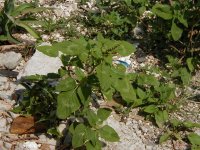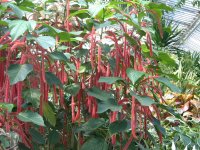amaranth (amaranth) - amaranthus l.
Amaranth family - Amaranthaceae
The botanical characteristics. Annual herb up to 1 m in height. It grows everywhere as a weed in crops, orchards, vegetable gardens, on vacant lots, roadsides.
The root extends, penetrates deep into. Stem erect, branched, pubescent. Leaves alternate, ovate-rhombic, elongated at the base into petiole, at the top with a notch. Fruit lenticular black. It blooms from June to September. It bears fruit until late autumn.
It grows several species. More often than others meet:
- Amaranth thrown back - A. retroflorum - plant pink and green, flowering branches are gathered into a compact panicle;
- Amaranth tailed - A. cordatus - with purple hanging panicles.
All kinds of drugs are amaranth, but the most medicinal properties has amaranth caudate.
Used parts of the plant. Medicinal raw materials are all parts of the plant. Raw materials collected during the entire growing season: the leaves - before flowering; flower panicles - during flowering; seeds - to the extent of maturation; roots - in the fall.
Amaranth as a valuable food culture has attracted worldwide attention. The US Institute of amaranth and research centers are studying the culture and introduce it in the food industry. This is due to the fact that the plant contains a lot of biologically active substances, mainly in the seeds from which the oil is amaranth.
Chemical composition. All parts of the plant contain nitrogen compounds betatsianidiny: Amaranthine, betanin, organic acids, vitamins, colorants, minerals.
Additionally Amaranth seeds contain a large set of amino acids, including the essential and protein with high protein content (18%). Protein amaranth seeds equate to a protein of human milk. According to the nutritional value of amaranth protein is far superior cow's milk protein and almost 1.5 times more than soy protein.
Amaranth seed oil contains a variety of unsaturated fatty acids and organic acids. The main component of the seed is squalene (above 8%). Squalene is a component of human skin and is directly involved in the exchange of oxygen to tissues and organs, protects the body from radiation, provides the body's resistance to various diseases.
Application. In the experiment, water extracts of the aerial amaranth have a bactericidal, protistotsidnym and diuretic effect. Fatty oil has anti-inflammatory, hemostatic, and antifungal action. A decoction of the roots is effective in the treatment of jaundice and guinea worm. Fresh juice and infusion exhibit antitumor activity.
In folk medicine, amaranth in the form of infusions and decoctions are used in the treatment of tumors of different etiology and localization of inward and outward; for the treatment of fungal diseases such as hemostatic agent for various bleeding in liver and heart disease, gastrointestinal infection; externally - with eczema, psoriasis, dermatitis, erosion, endometriosis, obesity.
A decoction of the roots and seeds are used in dysentery; in the form of baths - for various skin diseases, allergies, diathesis, rashes, often with succession and chamomile.
Fresh juice is diluted 1: 5 is used for rinsing the oral cavity, inflammations of mucous membranes. Juice flowering plant - an effective, anti-aging, cosmetic, strengthens hair roots and promotes their growth.
The oil used in burns, bed sores, insect bites, scars.
Young leaves are edible; seeds - as a seasoning for dishes.
preparation
- To take a decoction of 15 g roots or above-ground parts, milled, pour 200 ml of boiled water, in a boiling water bath for 30 minutes, cool 10 minutes, strain. Take 1/3 cup 3 times a day before meals.
- For infusions take 20 grams of leaves, pour 200 ml of boiled water, in a boiling water bath for 15 minutes, cool 45 minutes, strain. Take 2-3 times a day 1/3 cup before eating.
- For baths take 300-400 grams of raw materials, pour 2 liters of boiling water, boil in a saucepan for 15 minutes, cool 10 minutes, strain and add to the 1/2 bath 2-3 times a week for 20-30 minutes.




Comments
Commenting, keep in mind that the content and the tone of your messages can hurt the feelings of real people, show respect and tolerance to his interlocutors, even if you do not share their opinion, your behavior in terms of freedom of speech and anonymity offered by the Internet, is changing not only virtual, but real world. All comments are hidden from the index, spam control.